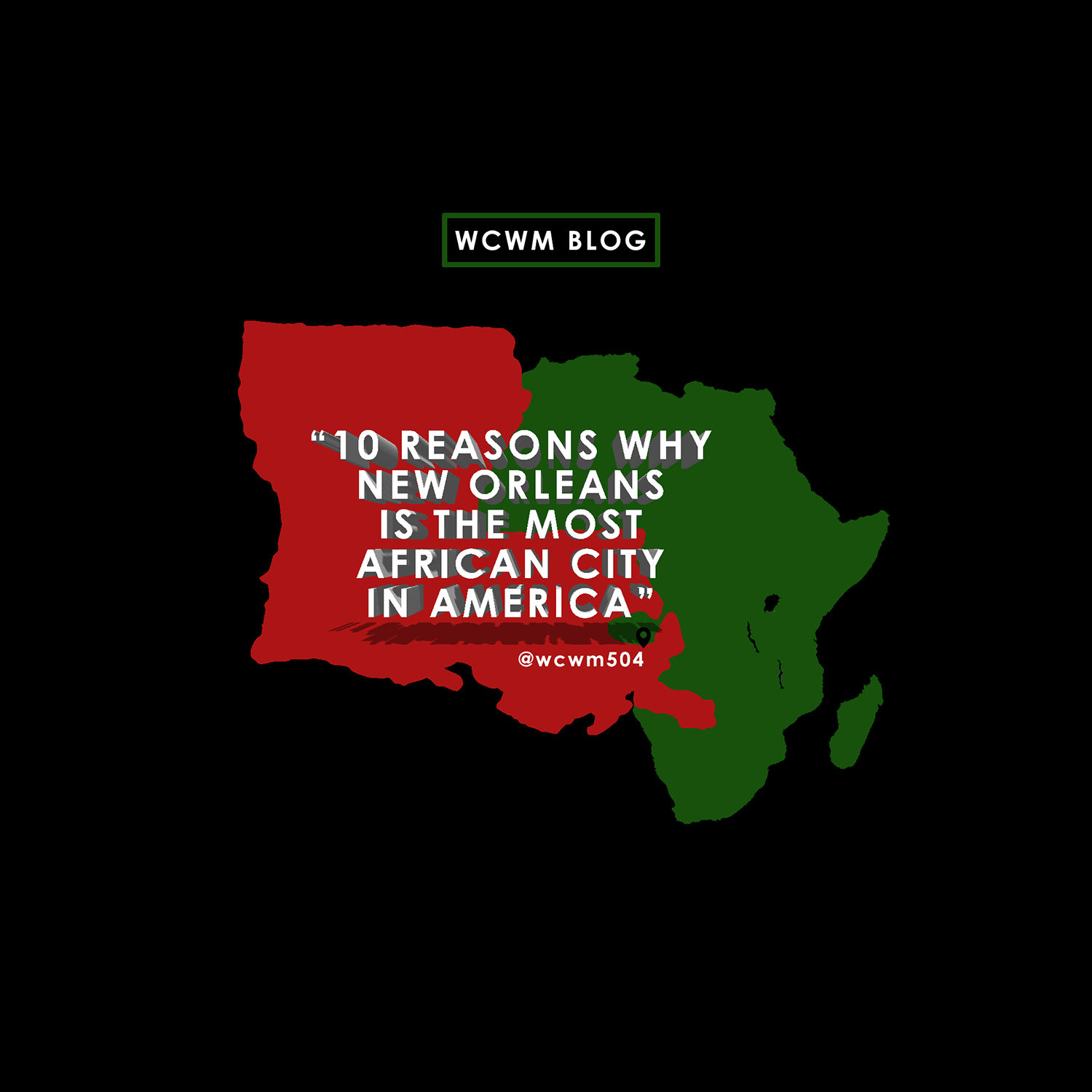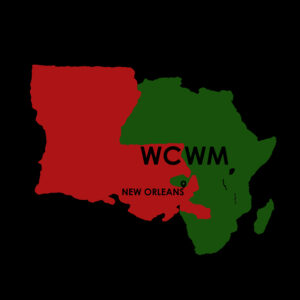June 15, 2018, by Christine Brown
New Orleans is the most African city in America. How do I know? Well, I’m from New Orleans, I’m a descendant of Africa, and though I haven’t been to Africa or many other places in America to compare, I know because I can feel it in my spirit. It’s in my DNA. And I knew it before I took my DNA test. Or before my father and son took theirs.
You know the saying, “I wasn’t born in Africa, but Africa was born in me?” Well, that’s how my dear, New Orleans makes me feel about my love, Africa. I have a few theories and historical facts to support my spiritual feelings. And I’ll share a few suggested readings and links at the end of this article too. I think this is a worthwhile subject to generate conversations, conjure spiritual awakenness, and spread history on.
I’m on a journey to further my understanding of what it means to be from the most African city in America. I am certain that such a title entails great responsibility from us who are from New Orleans. So while I am on this journey, I invite you to join me. This is a spiritual journey of discovery, healing, and direction. Who’s Coming With Me?

I’m not the first to discuss this topic and I hope I’m not the last, but it has been near and dear to my heart over the past decade, since I became more in touch with my African roots. I write this with hopes to re-connect, not only myself but, the African diaspora in New Orleans and across America to our roots, our Motherland, Africa. This is also intended to pay homage to those who contribute to the preservation of African roots in New Orleans.
In the spirit of educating and empowering people of the African diaspora in New Orleans, WCWM is proud to release “The Most African City In America” shirt. This shirt is an educational piece for all. It is also a fundraising effort that will help to further my research on this subject.
Featured on the back of this shirt are “10 Reasons Why New Orleans Is The Most African City In America”. We hope that this article, shirt, and history encourages more research, conversations, travels, and intentional celebrations of our African roots in New Orleans, especially during and beyond New Orleans’ 300th birth year. Let’s make sure New Orleans remains the most African city in America for another 300 plus years to come.
“The Most African City In America”
Shop WCWM Marketplace TODAY. FREE SHIPPING during JUNE 2018. PROMO CODE: FREEDOM2TRAVEL
There are certainly more than just ten reasons that New Orleans is the most African city in America but we thought we’d kick off the conversation with ten. Feel free to add any additional reasons in the comments of the article.
Here are our “10 Reasons Why New Orleans Is The Most African City In America”.
1. NEW ORLEANS WAS THE PRINCIPLE SLAVE TRADE PORT OF AMERICA.
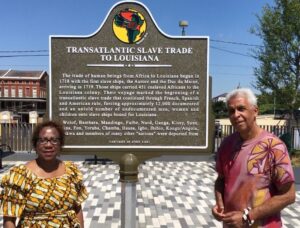
You probably know that the Port of New Orleans is a leading port in America. But did you know that New Orleans was the principle slave trade port in America during the Trans-Atlantic Slave Trade? It’s a painful fact of the past that carries a modern pain in the present; Louisiana is currently the prison capital of the world and New Orleans plays a major role in this.

Louisiana State Penitentiary aka Angola Prison is the largest maximum security prison in the country. It is formerly known as Angola Plantation, a plantation named after Angola, the Africa country. Many stolen Africans captured from Angola were brought to Louisiana as slaves. The cycle continues as many of the descendants of those enslaved African ancestors are incarcerated in Angola Prison.
Due to the history of New Orleans, Louisiana, survival for African descendants continues to be unjust. From the education and economic systems to the housing, health, and justice systems, the oppression and struggle of African people continue to fuel this country. African descendants in New Orleans have had to bear quite the burden of oppression in America.
The cases of Angola Three members, Robert King, Herman Wallace, and Albert Woodfox, are examples of modern-day slavery in New Orleans, Louisiana. Three young men from New Orleans were incarcerated in Angola Prison then put in solitary confinement for an inhumane number of years. Wallace and Woodfox were falsely accused of the murder of an Angola prison guard, and King was falsely accused of the murder of an inmate. Their extreme mistreatment was because the prison was intimidated by their powerful organizing and connection with of the Black Panther Party. Together, the Angola Three served over 100 collective years in solitary confinement.

Robert King served 29 years in solitary confinement. Herman Wallace served 41 years in solitary confinement. He was released in 2013, but due to illness, he transitioned three short days after his release. Albert Woodfox, the last of the three to be released from prison, served 43 years in solitary confinement. This is the longest solitary confinement sentence in the history of America. Clearly this a violation of the 8th Amendment, “no cruel and unusual punishment…”.

Above is a photo of Albert Woodfox and Robert King of the Angola Three, along with many of their Black Panther Party brothers. It was taken on February 19, 2016, Woodfox’s 69 birthday, at a film screening and panel discussion on the Black Panther Party. As the world and all major media outlets got the news of his release, Albert was being transported straight from Angola Prison to Ashe Cultural Arts Center, where he celebrated his homecoming with his Black Panther brothers and sisters, his community, his family.

The stories of the Angola Three are three in one of many others, that exposes New Orleans and Louisiana for its wicked injustice system. New Orleans being the principle slave trade port of America co-relates to the systematic oppressions of African descendants in New Orleans. Oppressions such as poverty, poor health, mis-education, and mental illness produce high crime, homicides, and incarceration rates. This formula is what America uses to keep slavery alive in the 21st century (via the 13th Amendment).
African descendants in New Orleans and America continue to struggle for their freedom and justice every day. Despite these struggles African descendants still manage to carry on many of their African traditions. This is one of the reasons that makes New Orleans most African in America. Though this isn’t such a happy fact, it is important history about New Orleans’ strong African roots.
2. LIKE AFRICA, COLONIZERS AKA GENTRIFIERS LOVE NEW ORLEANS BECA– — USE OF ITS AFRICAN PEOPLE, THEIR CULTURE AND CREATIONS.
“Don’t Sell Them People Your House. They Gentrifying Out’Chea…” Sign courtesy of BLKxLIGHT
This above message is brought to you by BLKxLIGHT. It is increasingly relevant to the climate of a Post-Katrina New Orleans. Colonizers/Gentrifiers are buying up the city and the cost of living has skyrocketed. While the racial income gaps brutally carve bloody “whites only” signs throughout much of our historically Black city, most Black New Orleans natives can’t even afford to live in their own city.
One of BLKxLIGHT’s t-shirts reads, New Orleans vs Gentrification. This has been a struggle designed against Black people in New Orleans for many years. Most certainly it was in the works when they started shutting down the projects, trading the public schools and teachers for Charters and Teach for America. Need I mention, when they broke the levees after Hurricane Katrina. It’s just unfortunate that we didn’t see the signs, work together, and jump on the opportunities to keep our city before the prices segregated those opportunities.
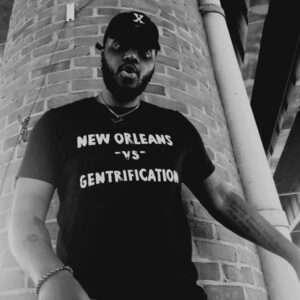
As described on their website, “BLKxLIGHT stems from recognizing that there is a drought in our communities when it comes to positive imagery that reflects where we come from, who we are, and who we have the potential to become…” We, at WCWM, are in full support of BLKxLIGHT’s work and creative expressions.
Another awesome shirt that connects with a message I have overstood and spoken on for some years is this “Everything You Love about New Orleans Is Because of Black People” shirt by another local t-shirt company named Little Pralines.

This shirt reminds me of my message at a 2015 City Council Public meeting about why four white supremacist confederacy statues should or shouldn’t be removed. The city council chambers were packed and open for community consideration of the statue removals. People for and against the statues being removed signed up to advocate their stance. Many of the people against the statues being removed were white supremacists from other states.

When I spoke to the City Council, I stated that everyone in the room loved New Orleans because of everything that Black people bring to the city. From the food to the music, to the art and culture, New Orleans is New Orleans because of Black people. A few minutes after I spoke, a white woman repping “All History Matters” began to present her point “you can’t change history”.
As she proceeded with her argument, she told a story of a Louis Armstrong painting she bought from a New Orleans painter. She said she questioned the artist about why he painted a cigarette in Louis Armstrong’s hand. The artist’s reply was because Louis Armstrong smoked cigarettes. She said she had to accept the fact that she can’t change history. In closing, she then pulled the Louis Armstrong painting from her bag to show it to the City Council members, turned around to show the painting to the crowd, then went to her seat.
My argument was she bought a painting of a Black musician from a Black painter. Coincidentally, it wasn’t just any painter, it was my little brother, Bryan Brown.

She actually brought my brother’s art piece to the city council meeting to prove her point that “you can’t change history” and “all history matters” but what she really did, was prove that Little Pralines t-shirt and my argument was 100% accurate. “Everything you love about New Orleans is because of Black people.”
3. MANY NEW ORLEANS’ FOODS HAVE AFRICAN ORIGINS AND INCLUDE CROPS CULTIVATED BY AFRICAN PEOPLE.
America still reaps the benefits of African people and their unpaid labor. One of the many benefits is agriculturally. African people brought many of their native foods to America. Additionally, they also cultivated many foods that are essential to New Orleans’ food culture. Crops such as sugar cane, black eye peas, coffee, watermelon are just a few contributions from African people.
Gumbo is a signature New Orleans dish. The word gumbo is an African Bantu word that translates to okra. It is inspired from a West African dish. It can include different kinds of meats, seafood, herbs, and spices as sometimes okra.

Okra, a crop brought to America from Africa, is cooked in many New Orleans dishes, including okra and tomato stew, shrimp and okra, and succotash. Succotash is a southern dish that also includes lima beans, which were brought to America from Africa.


Rice is another major New Orleans commodity brought to America and cultivated by African people. Can you imagine a bowl of gumbo without a scoop of rice? What would a Monday in New Orleans be like without a classic dish of red beans and rice? We have the hard work and unpaid labor of African people to thank for these dishes.

Currently, we have some great chefs, and health conscious cuisine companies doing great things in our community. From Vegan Chef Nola to Froot Orleans, they are taking charge of the cities health while also keeping the unique African inspired New Orleans swag. Companies like Mama Isis Farm & Market are using their green thumb to bring farming and natural herbs back to the community. UDA offers flower bed building services to anyone interested in gardening. This is the New Orleans that we must cultivate for the future.

4. MANY AFRICAN SYMBOLS ARE INCLUDING IN NEW ORLEANS’ ARCHITECTURE.
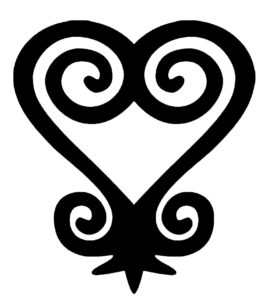
As African people were enslaved and forced into free labor, many of our ancestors brought their spirituality and languages with them. Though communication wasn’t always allowed among enslaved people, they found ways to communicate through songs and even symbols.

Much of New Orleans’ architecture, especially the ironworks, was created by enslaved African people and cleverly, they included African symbols in their work. A popular symbol used throughout the city is an Adinkra symbol called the Sankofa. Sankofa means to go back and get it or to learn from the past. This symbol is also represented with a bird reaching back to an egg that is on its back. I find it significantly powerful to have a constant reminder re-directing African people to, Sankofa, learn from the past.

The fleur-de-lis is probably the most popular symbol in New Orleans. It’s so popular here, it is often used to represent the city of New Orleans. You can find fleur-de-lis throughout the city almost anywhere including rod ironwork, stuckle, and woodwork.
The fleur-de-lis is also a very popular tattoo for New Orleanians. It is a symbol that has helped many displaced New Orleanians feel connected to home. Many New Orleans businesses or businesses of people from New Orleans often use this symbol in their logos or on their buildings.

The New Orleans Saints use the fleur-de-lis as their logo for their national football team. It is also found on the Louisiana French coat of arms. On a much darker note, the fleur-de-lis symbol was used to brand enslaved Louisiana people who ran away from the plantation. Many people criticize the use of the fleur-de-lis because of this notion, however, the roots of the fleur-de-lis go back even further than slavery.

The fleur-de-lis translates to “flower of the lily”. It is connected to the lotus flower, the three-pronged flower of Egypt. The lotus flower is symbolic of the Nile River’s streams. You can find images of this three-pronged flower in many Egyptian hieroglyphics.

I had the pleasure of learning much of this information through a short documentary project I worked on with Ashé Cultural Arts Center called The Redemption of the Fleur de Lis. Carol Bebelle, Co-Founder/Executive Director of Ashé, shared a book with me titled, Fleur of the Nile. It’s a great book to check out.

5. NEW ORLEANS IS THE HOME OF THE HISTORIC CONGO SQUARE, A SACRED GATHERING PLACE FOR AFRICAN PEOPLE SINCE THE LATE 1740s.
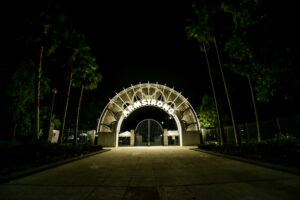
Located inside of Armstrong Park in New Orleans, Congo Square is the oldest gathering place for African people in the country. Since the late 1740s during slavery, African people in New Orleans, gathered in Congo Square on Sundays for dance, music, spiritual works, markets, and to, seemingly, have a day off to connect with their African roots and people. Many times even free people of color came out to Congo Square to connect with their culture as well.
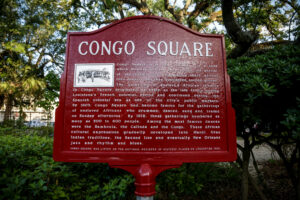
In 1997, Congo Square received a historic marker. 20 years later, in 2017, it was refurbished in red and unveiled by the Congo Square Preservation Society. The Congo Square Preservation Society, formerly known as The Congo Square Foundation, has been the major catalyst in the resurrection and continuation of activities, advocacy, and preservation of historic and sacred Congo Square since 1989.


Currently, you can visit Congo Square throughout the week, however, on Sundays 3-5pm you can join the traditional drum and dance gatherings led by the Congo Square Preservation Society. Donations and memberships are encouraged to support the work of keeping this historic sacred space available to the African diaspora.


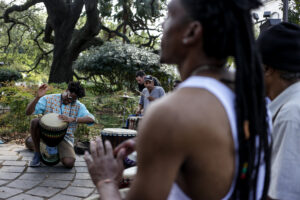

Other special events and festivals happen in Congo Square throughout the year, such as the Congo Square Festival, Jazz in the Park, The Celebration of the African American Child, Maafa, and more. Many times Congo Square is the go-to space for community healing circles, the culmination of protests, press conferences, weddings and even repasses. Spiritual rituals and practices are especially among some the activities that take place in Congo Square. Many times their practices are done at the foot of the ancestor tree, one of the oldest trees in the park.



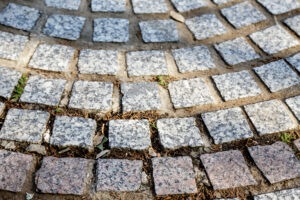
One local shero, who has invested much of her research and heart work to sharing the history of Congo Square, is historian, independent scholar, author, and arts educator, Freddi Williams Evans.


Freddi Williams Evans was essentially the driving force to encourage the creation of the 2011 ordinance that officially renamed the historic Congo Square, Congo Square. Mrs. Evans is the author of several books including “Congo Square: African Roots in New Orleans” and her latest book, “Come Sunday: A Young Reader’s History of Congo Square”.
Each of these books deserves to be a part of your collection and knowledge base. I’m not just saying that because she gave a shout out to BYP100 Nola, a chapter of BYP100 that I founded, and Take Em Down Nola, an organization that branched out from BYP100 Nola. But that just adds another reason for you to add it to your book collection.

It’s truly an honor to know this amazing scholar and legend. Just think. Without her contributions, Congo Square could still be named after a Confederate general and white supremacist. Asante Sana to you, Mrs. Freddi, for helping to preserve and share our history. #TakeEmDownFreddi

6. THE OLDEST AFRICAN DIASPORIC NEIGHBORHOOD IN THE COUNTRY, TREME, IS IN NEW ORLEANS.

You probably heard of Treme from the HBO TV Series. If not, then maybe you have heard of jazz music which was born in the Treme neighborhood of New Orleans. Well Treme is the oldest African America neighborhood in the country. Historically known as “Backatown” to signify the area behind Rampart, Treme was also where most free people of color lived.
In addition to jazz, Treme gave birth to some of the most magical musicians in New Orleans. Such contributions like world renowned “Rebirth Brass Band”, co-founded by Kermit Ruffins, was formed in Treme. Troy “Trombone Shorty” Andrews is another successful young musician raised in Treme. He began playing the Trombone at the age of 4. I believe, it is the spirit of our African ancestors, their music, and culture that makes this neighborhood and community such a powerful contribution to the city and the world.

In additon to Treme’s history as a neighborhood where many musicians and artists, lived, worked, and created, it is also where many historic African and African diasporic gathering places are. Congo Square and Mahalia Jackson Theater, located inside of Louis Armstrong Park, are in the Treme neighborhood. St. Augustine Church, the oldest African America Catholic parish in the country is located in Treme too. Powerful freedom rider and community leader, Jerome “Big Duck” Smith is from Treme and is a director of Treme Recreation Community Center, a staple in the Treme community. Even Angola Three member, Albert Woodfox, grew up in Treme.
Currently, Treme has been heavily gentrified and it is becoming increasingly more difficult for Black New Orleans artists, musicians, and creators to live in this historically Black neighborhood. A recent article headline read, “Treme home built with affordable a housing grant currently a $400 per night air bnb”. This is one of many other ways Black people are being outpriced in their neighborhoods and city.
I couldn’t help but think about this powerful t-shirt from Local New Orleans, a t-shirt company. It reads “Make Treme Black Again”. We need to bring all of our Trombone Shorty’s, Kermit Ruffin’s, Brass bands, spiritual workers, and community leaders together for a meeting of the minds to take action before it is too late.

7. IN NEW ORLEANS, MANY AFRICAN AND AFRICAN INSPIRED TRADITIONS ARE STILL PRACTICED TODAY.
New Orleans is a city rich in traditions and culture. From the Mardi Gras Indian culture to African spirituality, New Orleans is a place like none other in the country. What a blessing to be able to call this place home.



Living in a city that never sleeps, its only natural that you don’t get to experience all its excitement. I don’t make it to as many second lines as I’d like but I get to live out the celebration through images from young photographer prodigy, Patrick Melon. Patrick is a second line photographer guru, aka a modern day Eric Waters. He captures the cities second lines like none other. I’ve included some of his photos to share the powerful unity that he captures at our New Orleans second lines.

When I think of New Orleans second lines, I think about a place of unity among New Orleans people, Black people, people of African descent. Some cases of unfortunate violent acts have taken place at second lines and caused some negative stigmas to form about the tradition. However, I believe the majority of the people who come out to second lines come out to experience and celebrate the culture.
How powerful would it be, if all of the Mardi Gras Indian tribes, Brass Bands, Second liners, Social Aid and Pleasure Clubs, and Culture Bearers came together to develop and educate people on keeping and protecting the culture? In addition, it would be important to create community accountability protocol for violators who taint the culture? I believe such actions and messages are necessary to the set the standards of unity, love, and respect between the culture bearers as an example to the community. We must adopt the parts of African culture that shows communities coming together but also being accountable to each other. Together we can do this in love.
The traditions that New Orleans continue to practice and pass on is one of the most unique parts of the city. It is one of the largest parts of what makes it the most African city in America. These traditions must be passed down with care and in better conditions then what we received them. It is our duty as the most African city in America. The next generations are following our lead. It is up to us to guide them in the spirit of unity, love, and respect. This is what should guide 100% of their footwork.

8. THE ART OF STORY-TELLING IS A PART OF NEW ORLEANS THAT IS ROOTED IN AFRICAN CULTURE.
Ever noticed how people from New Orleans say bye or see you later almost five times before they actually depart from events or conversations. That’s because we are natural storytellers. Story-telling is a major part of New Orleans culture, as it is of African culture. It’s also a part of why New Orleans people like to greet people when they enter each other’s space or pass by you while walking down the street.
“What’s up”, “How ya doing”, “How ya mama nem” are all some common greetings you might hear from New Orleans people while walking up any given New Orleans street. Some may call it “southern hospitality” but I call it “African hospitality” because as natural as Africans, New Orleans people love to speak to and look out for each other.
Storytelling has been a part of my New Orleans roots since my elementary school days. One of our most popular community storytellers was Adella Adella the Storyteller aka Adella Gautier. If you attended public schools in New Orleans the Hurricane, chances are you got to experience this wonderful storyteller throughout your childhood.

Some other great elder storytellers are Mama Olayeela Daste, Mama Jennifer, Chakula cha Jua, and John O’neal. These wonderful storytelling artists, many of whom are battling illnesses, are community treasures.
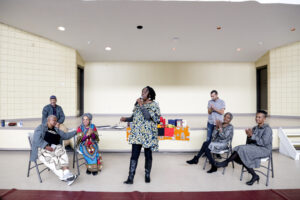




As many of our storytellers face some of the challenges of aging, it is pressingly important that the storytelling traditions get passed along and kept alive in New Orleans culture. One young playwright, mother, and storyteller that is keeping the tradition alive is Briceshanney Grisham. She occasionally hosts community storytelling events in the city. During July and August, she will be hosting kids summer workshops at the Broadmoor Wellness Center on the Westbank. (more info in events suggestions at the end of this article)
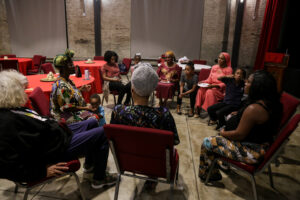
A few days ago, I walked into Community Book Center on a Wednesday morning and was pleased to see some community mothers have started a weekly storytelling event. They will be hosting them at Community Book Center 11 am on Wednesdays. Mama Jennifer, co-director of Community Book Center, scholar, and one of the communities most treasured storytellers, was present and happily documenting the storytime on her cellphone.

Wendi O’neal, daughter of actor, director, writer, and freedom rider, John O’neal, is keeping the storytelling tradition alive by using story circles, a group storytelling technique. Wendi is a cultural worker, activist, facilitator, and educator. She is the founder of Jaliyah Consulting, an organization that uses freedom singing, story circles, and group facilitation to share civil rights movement history, culture, and traditions. Jaliyah Consulting hosts a bi-weekly event called The People’s Community Sing. (more info in the events section at the end of this article)
Ashé Cultural Arts Center produces an annual play adapted from David Anderson’s book called “The Origin of Life on Earth: An African Myth”. This story is a beautiful introduction to the different Orisha deities. Narrated by the co-founder of Junebug Productions, John O’neal, Origins is a great story that connects African origins and the connection to African people in New Orleans.

It wasn’t until I visited Cuba, a country rich in African spirituality and roots, that I saw such a play with powerful African spiritual connections. While many Black people in New Orleans may have never experienced plays or productions like “Origins” or the one I saw in Cuba, I do think it is very important that exposure to storytellers and stories, especially African stories, become more pronounced in New Orleans Black culture.
I consider myself a storyteller as well. Though my most pronounced form of storytelling isn’t oral, I do use photography and film as well in addition to writing, poetry, music, and fashion to tell stories. I’m currently working on my first narrative short film production called The Essence of N.O.W., set to be released in late 2018. The Essence of N.O.W. is a story of a New Orleans woman on her journey to self-love, healing, and sisterhood. It is a silent film that is told through all original songs from New Orleans women. This story is an ode to Black women in New Orleans and to the strong African roots in New Orleans.

9. THE AFRICAN SPIRITUAL PRACTICE OF HONORING ANCESTORS IS A PART OF NEW ORLEANS CULTURE.
New Orleans is known for their jazz funerals and second lines. A jazz funeral is a funeral procession accompanied by a brass band. People take to the streets often dancing in a very spiritual manner. This tradition of celebrating the life of the deceased is connected to the West African Yoruba religion among others. Below is a photograph of a woman dancing on top of a casket. This photograph was taken by New Orleans photographer, Eric Waters. Eric Waters is known for his jazz funeral, second line, and social aid and pleasure club photography. He has a book called Freedom’s Dance that shares many of his images and information on the culture.


My 2006 introduction to Ashé Cultural Arts Center is where received most of my African cultural awareness. Ashé is an art space dedicated to culture, community, and commerce. Co-founded in 1998 by Carol Bebelle and the late Douglas Redd, this tricentennial birth year for New Orleans is Ashé’s 20th birth year.

For the past 17 years, Ashé has hosted a commemoration of our ancestors from the Trans-Atlantic Slave Trade. This commemoration is called “Maafa” which translates to “great tragedy” in Kiswahili. It refers to the period called the Middle Passage or Transatlantic Slave Trade.
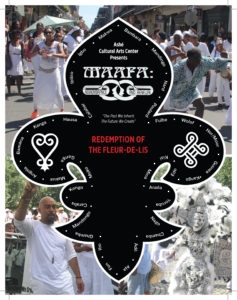
This year on July 7, 2018, Ashé presents the 18th Annual Maafa “A New Orleans Tricentennial Commemoration”. Starting at 7am inside at Congo Square in Armstrong Park 701 N. Rampart St. Per the Ashé website,”The MAAFA Commemoration offers an opportunity for the whole community to pause and reflect on this great transgression against humanity and to personally, as a community, agree to distance ourselves institutionally in word and deed from that transgression, its legacy and the evolved practice of racism in our civic, social, spiritual and personal lives.”
For more information on Maafa. Click the Maafa flyer below.

I’ve had the pleasure of attending quite a number of Maafa Commemoration’s and each year, I must say, it is growing and becoming more powerful. Below are a few photos I took during different years at Maafa.
Often at African spiritual gathering and ceremonies, people wear white attire. Below is a photo of a homegoing ceremony for a great New Orleans leader, Mama Suma held in Congo Square. Big Queen Ausettua of the Washitaw Nation Black Indian Tribe lifts her hand, sending praises up for ancestor Mama Suma. Though Mama Suma has transitioned into the ancestor realm, through African rituals, her family, contributions, and community, her spirit lives on.

If there is one thing that I understand about African spirituality, it is that it is an important part of our culture that was stolen from us and is being used against us. Though there are individuals who righteously practice African spiritualities in New Orleans, one would think that being the most African city in America, it would make African spiritual practices the norm. Unfortunately, it is not as prevalent as other colonized religious practices. However, I believe African spirituality is the answer to many of the problems we face in our communities today.
Sula Spirit of the Temple of Light: Ile de Coin Coin is a spiritual leader in New Orleans who has a beautiful spiritual shrine designed to support African people in spiritual cleansing and guidance. Sula Spirit’s Temple of Light is a highly recommended grounding place for spiritual balance and guidance.
Currently, I don’t have a specific African spiritual practice that I have chosen for my life’s path. However, I have adopted some of the common practices of honoring our ancestors, opening up space with them, pouring libations, and honoring their names. These are some of the rituals I have picked up from some of my closest, trusted spiritual beings and workers.
Whenever, I have a chance to host a gathering, especially with African people, I take time to open up the space paying homage to our ancestors. In doing so, I usually pour a libation, a drink poured out as an offering to a deity. This is something often seen during Kwanzaa celebrations in New Orleans as a way of connecting African descendants to some of Africa’s culture.

Another place African American may have seen libations is in movies and music videos. DRS’s 1993 hit “Gangsta Lean” is my earliest memory of libations being poured in the form of a 40 ounce being poured out for the lost of their homies. Their lyrics sing “I tilt my 40 to your memory…”

In 1994, Tupac Shakur came out with a song called “Pour out a Little Liquor”. Even in this gangsta rap song, he is referencing his connection to African spirituality via pouring a libation. Tupac probably was exposed to African spirituality via his mother and her connection to the Black Panther Party. However, I wonder if DRS was aware of the African libations then or even if other hip-hop artists and fans got the connection back then. I know I didn’t.

Our ancestor names being lifted up in songs is also a connection to African spirituality. In, New Orleans rapper, Master P’s 1997 song, “I Miss My Homies”, he calls out the names of some of his loved ones that he lost. There is even a sand scene in his video that looks just like the “ancestor’s plain” scene in Black Panther. I guess the records Master P broke can be considered sort of Wakandan for the Calio ice cream man.
Perhaps Haitian hip-hop artist, Wyclef Jean is an artist more likely to be aware of his African roots, given Haiti’s rich African roots. In his 2000 album, Ecleftic, he included calling the names of the ancestors and pouring liquor in his song called Thug Angel. Haiti and New Orleans have quite a strong connection due to the history of slavery. I haven’t been to Haiti yet but I have been to the neighboring country, Cuba, which has similar connections to Africa and New Orleans for some of the same reasons.
Through my travels to Cuba and experiencing their strong presence of African spirituality, it was clear that Cuba practices African religions more primarily then New Orleans. And even though African spiritual practices take place in New Orleans more than many other places in America, I am even more convinced that we should be growing our spiritual practices more in New Orleans.
In my lifetime, one of the most powerful examples of African spirituality being used by African people is around the removal of Robert E. Lee and three other symbols of white supremacy in New Orleans. As a direct organizer in the removal of these symbols, I largely credit the removal of the statues to the intentional spiritual rituals that were performed at the spaces throughout the organizing of their removal.
Ifa Seyi, ordained West Afrikan Yoruba Ifa-Orisa Priest, was a leading spiritual worker to support the removal of these statues, particularly Robert E. Lee. We give thanks to those spiritual workers and practices that are used to guide and protect us. Below are photos from 2014-2017 that show the process of removing the statues.




10. FOR MAJORITY OF NEW ORLEANS’ 300 YEARS, IT HAS BEEN POPULATED BY MOSTLY PEOPLE OF THE AFRICAN DIASPORA.
Though many people of the African diaspora remain displaced since Hurricane Katrina in 2005, Black people still remain the majority of New Orleans’ residents. Gentrification, poor education, lack of career opportunities, and poverty continue to make it difficult for Black people to flourish in New Orleans. Such symbols of white supremacy represent many of the injustices Black people face in the city.
I’m an avid advocate for Black people uniting and practicing group economics as a way of bringing forth their own freedom and power. New Orleans wouldn’t be able to survive without all of the contributions African descendants continue to bring. It is beyond the time that we come together and put our money where our melanin is. When we come together to educate, empower, create, and support our communities, there won’t be room for outsiders to come in and violate our spaces.
Below are some beautiful photos of what Black unity looks like in New Orleans. Together we can make sure New Orleans remains the most African city in America for 300 years to come.


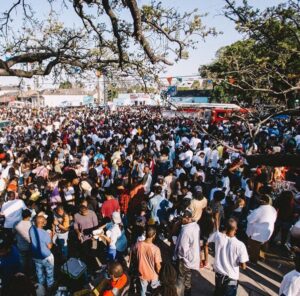
Suggested reading materials:
Come Sunday by Freddi Evans
Congo Square: African Roots in New Orleans by Freddi Evans
Fleur of the Nile by Casey Delmont Johnson
Freedom’s Dance: Social Aid and Pleasure Clubs in New Orleans by Eric Waters and Karen Celestan
Marking Time Making Place by James B. Borders IV
Suggested organizations to support:
Andrew’s Welding & Blacksmith Shop
Art Journey Allen Gallery & Studio
Claiborne Corridor Cultural Innovative District
Congo Square Preservation Society
Ellis Marsalis Center For Music
New Orleans Master Crafts Guild
UDA (United Descendants of Africa)
Wholely Living, Simply Living
Artists and Culture Bearers referenced in article:
Suggested African and African Inspired Restaurants to support:
14 Parishes Jamaican Grill
Abyssinia Ethiopian Restaurant
Bennechin African Restaurant
Black Swan Food Experience
Boswell’s Jamaican Grill
Cafe Porche
Coco Hut Caribbean Restaurant
Dooky Chase
Froot Orleans
Krewe du Brew
Lil Dizzy’s
Mama Isis Farm & Market
Ms. Beasley’s
Queen Trini
Sweet Vegan Soul Food
The Half Shell on the Bayou
Vegan Chef Nola
Veggie Nola
Suggested events to attend:
The People’s Community Sing 4-6PM
1st & 3rd Sundays of the month
People’s Assembly – 1418 N Claiborne Ave
Juneteenth Celebrations
Saturday, June 16, 2018 – Stand with Dignity – Juneteeth Block Party – 2-7p 217 N. Prier St.
Saturday & Sunday , June 16 & 17, 2018 11am-7pm – CID_NOLA – Kings Corridor Weekend – N. Claiborne & Orleans
Tuesday, June 19, 2018 – UDA – Nola Juneteenth Celebration – 3p-8p L B Landry-Walker 1200 L B Landry Ave.
Lecture by Professor Griff – 10pm – Cafe Istanbul 2372 St. Claude Ave.
Ashe’ 18th Annual Maafa Commemoration
Saturday, July 7, 2018, 7 am – Congo Square
Storyjamas Kids Summer Workshops
July 23, 27, 30 & Aug 3 4:30-6pm
Broadmoor Wellness Center – 3700 General Taylor
THANK YOU FOR SUPPORTING THE AFRICAN ROOTS OF NEW ORLEANS!

